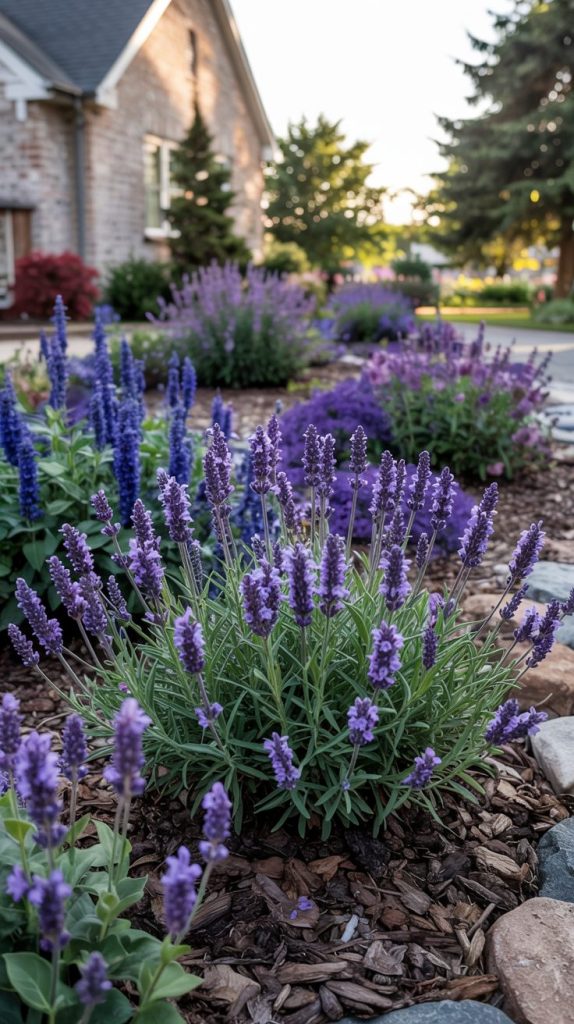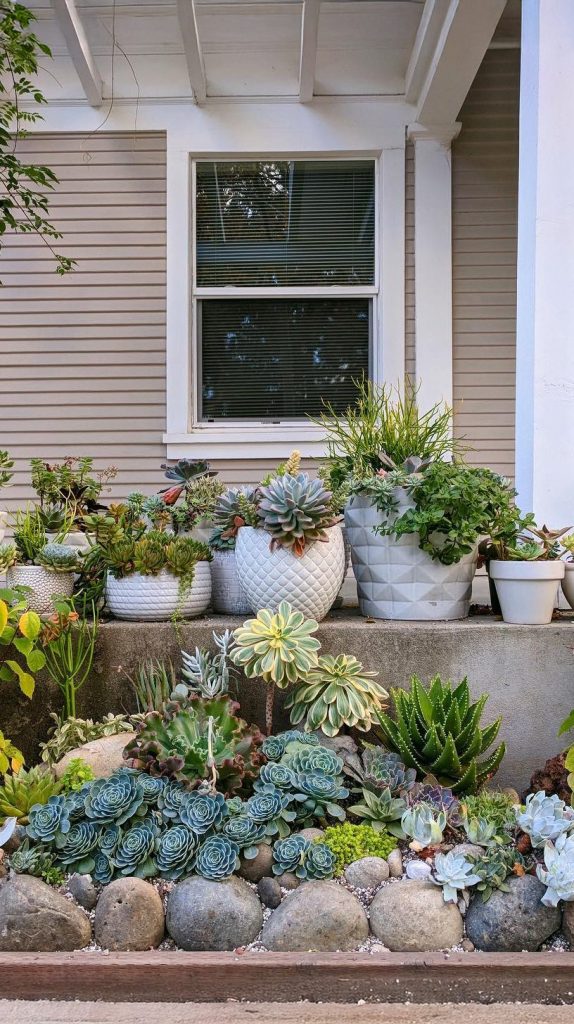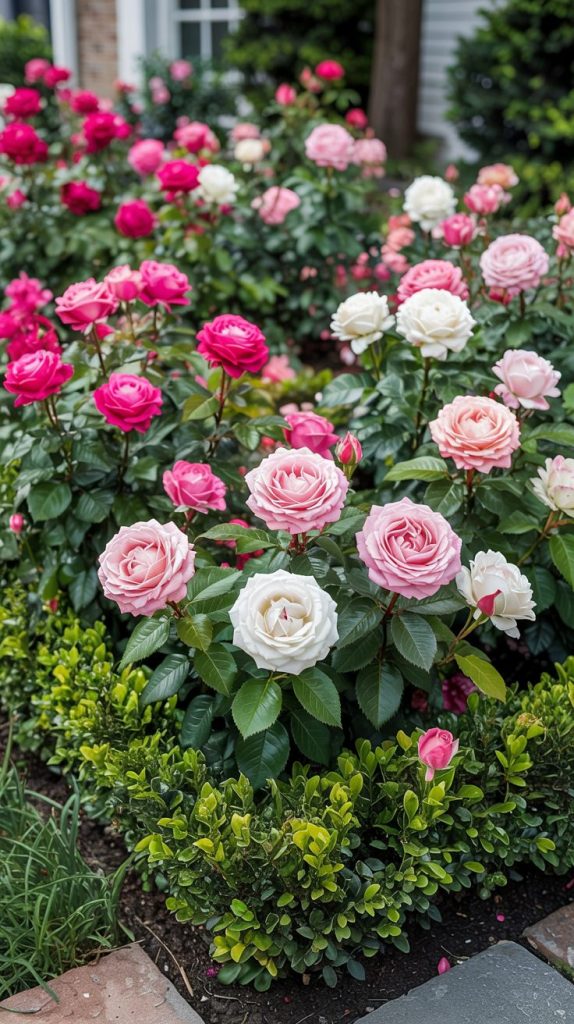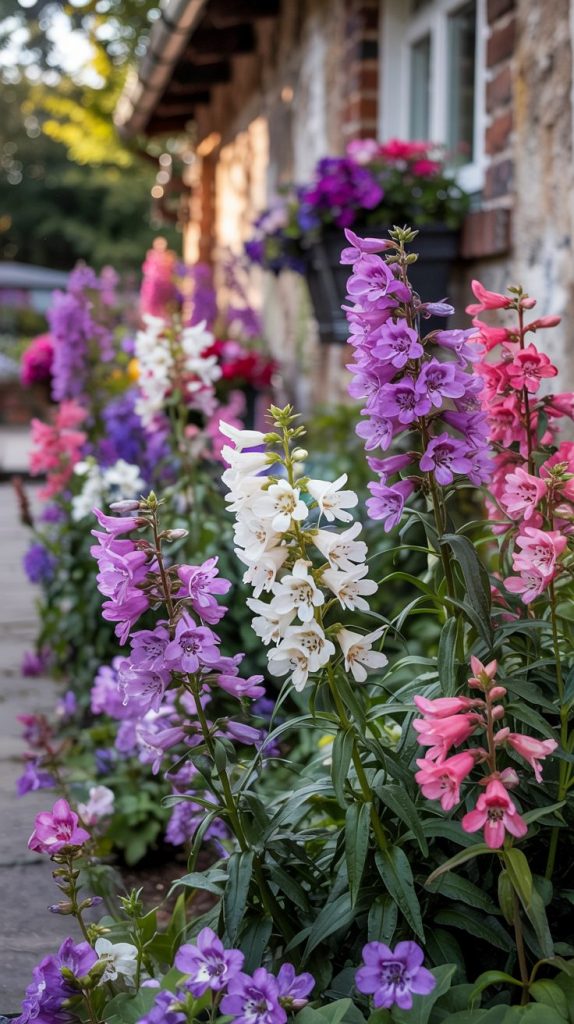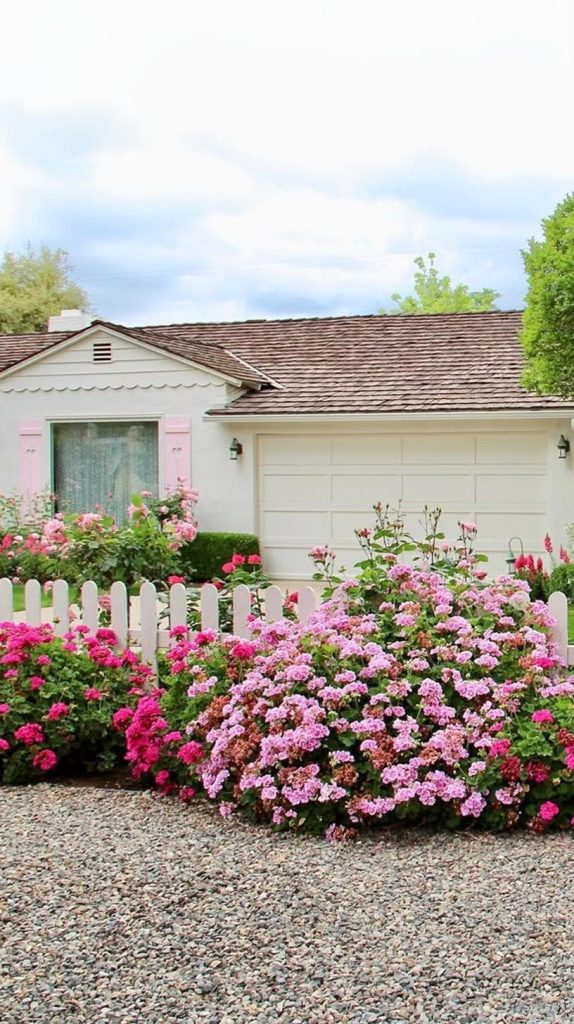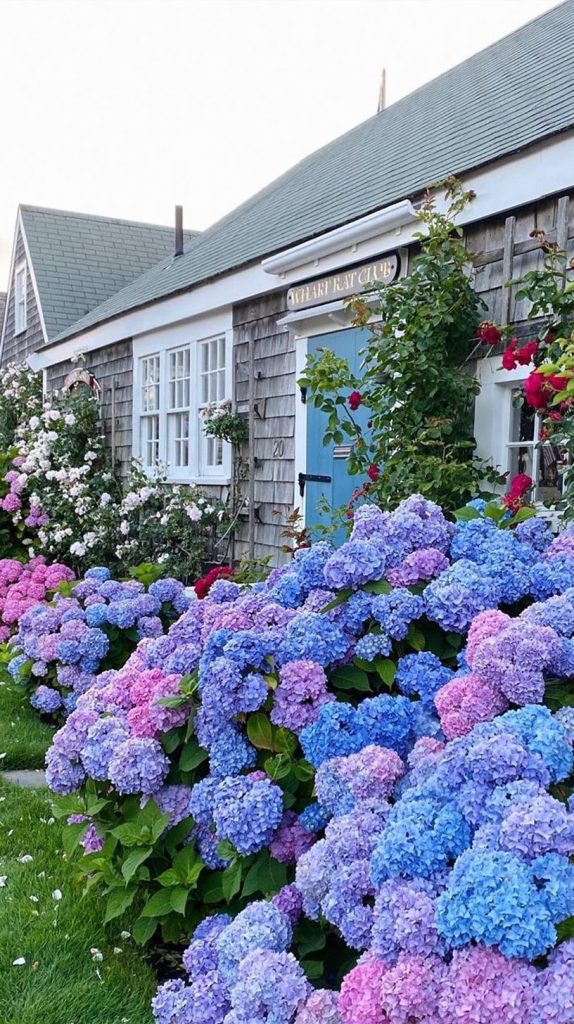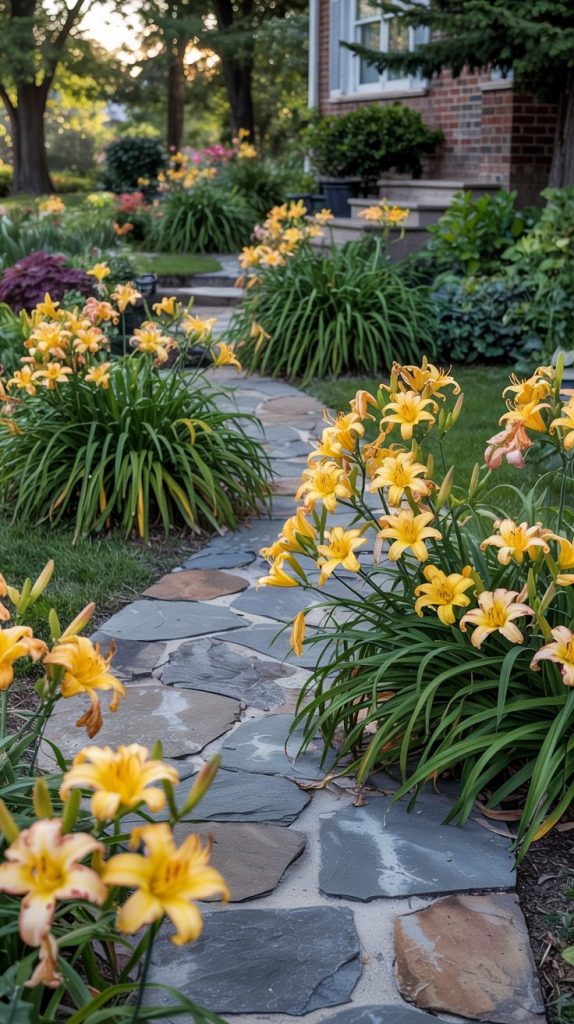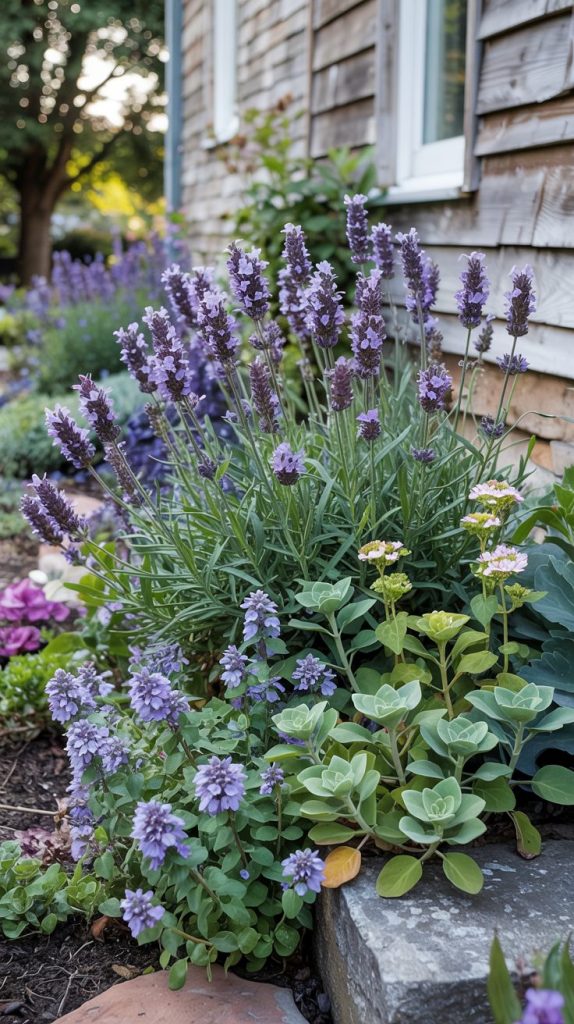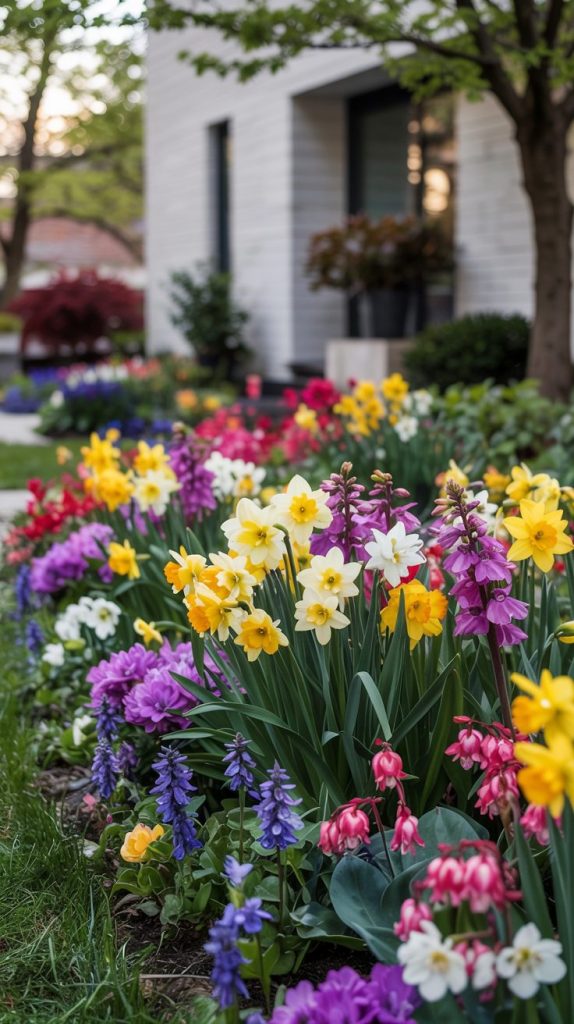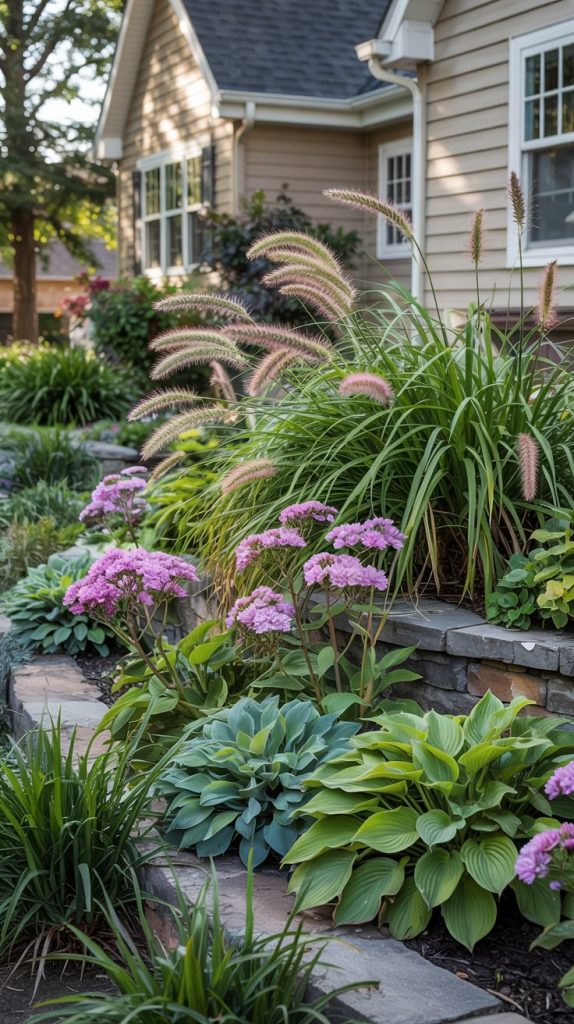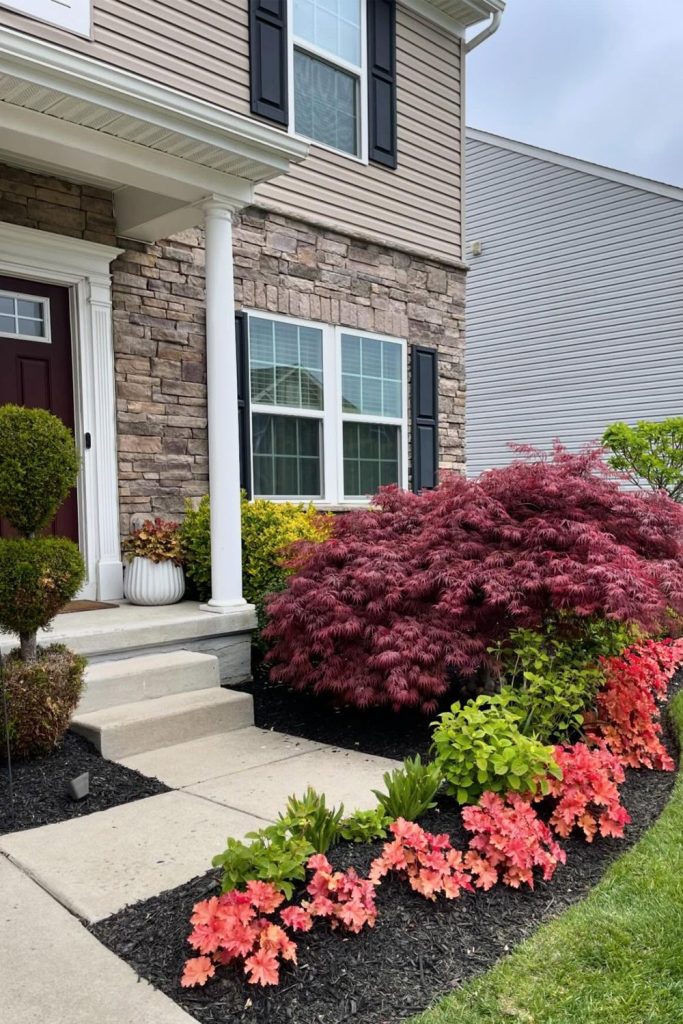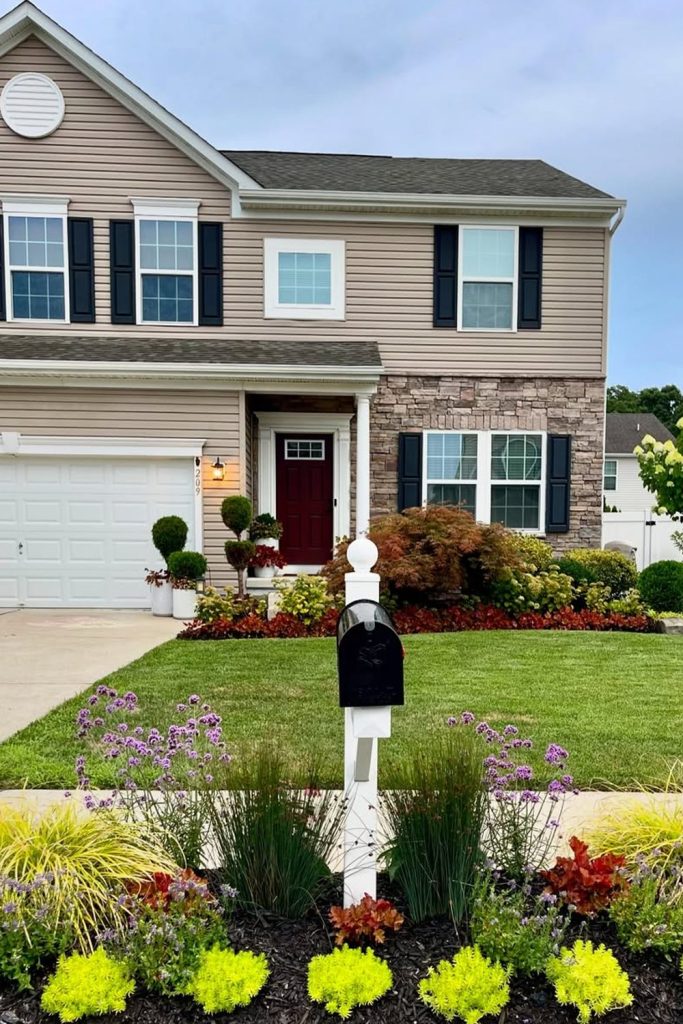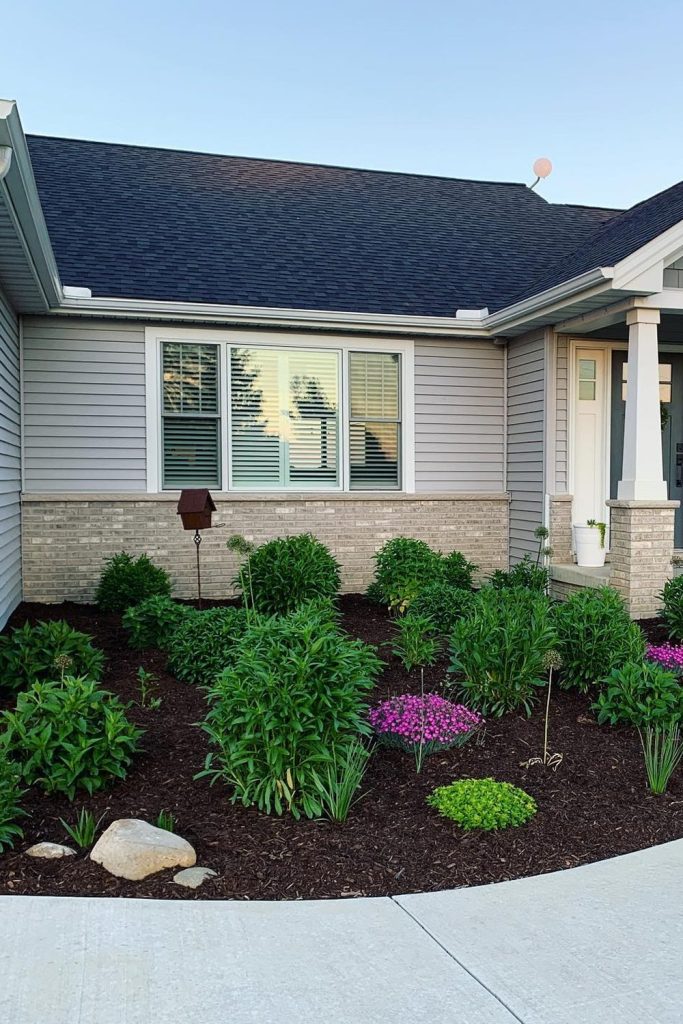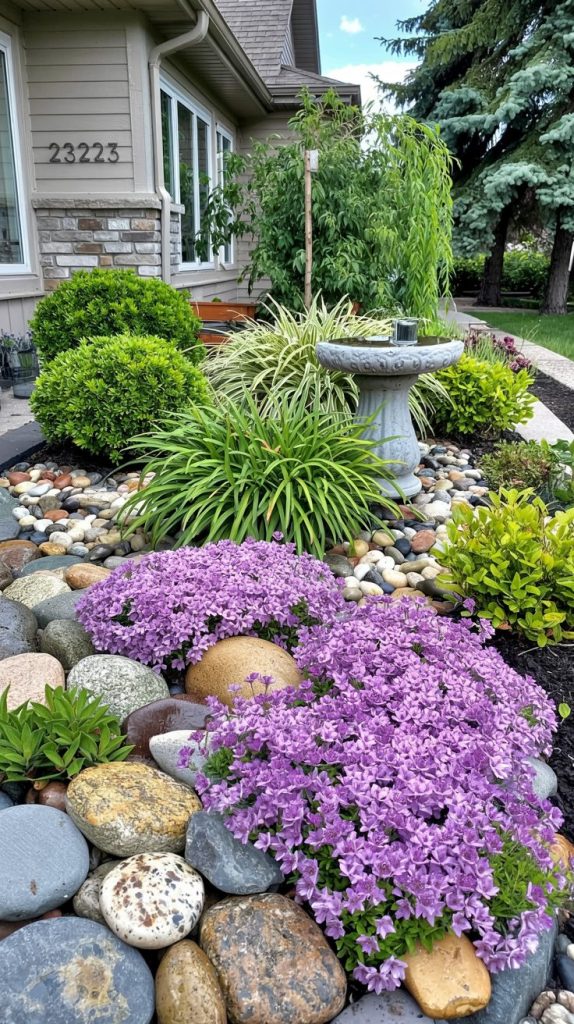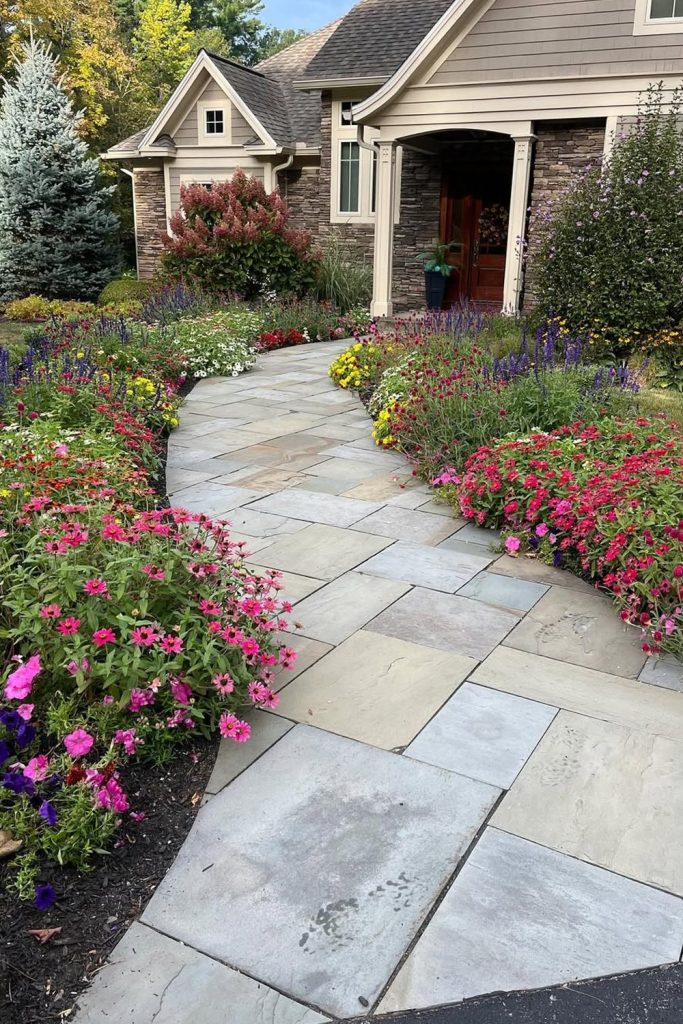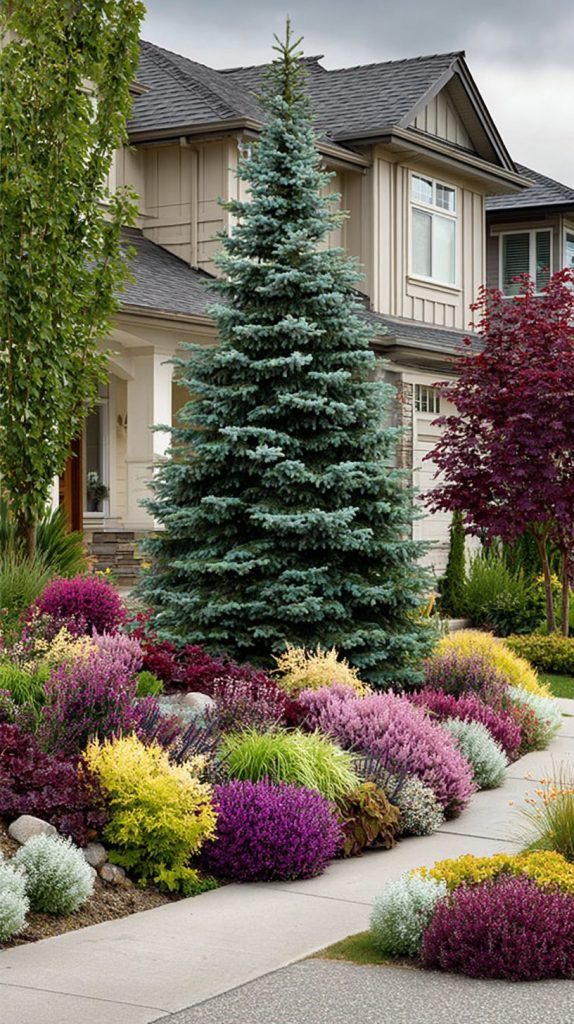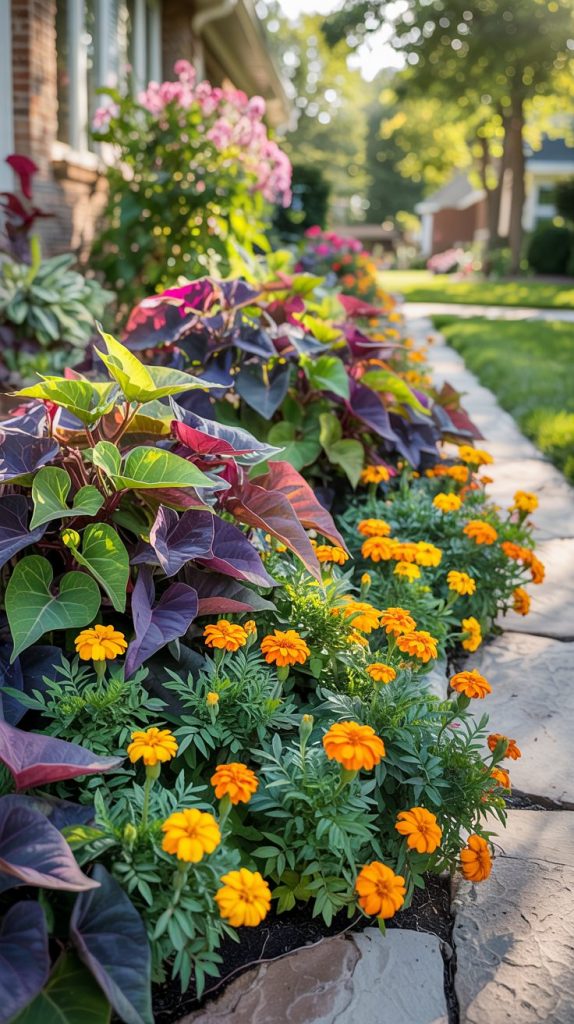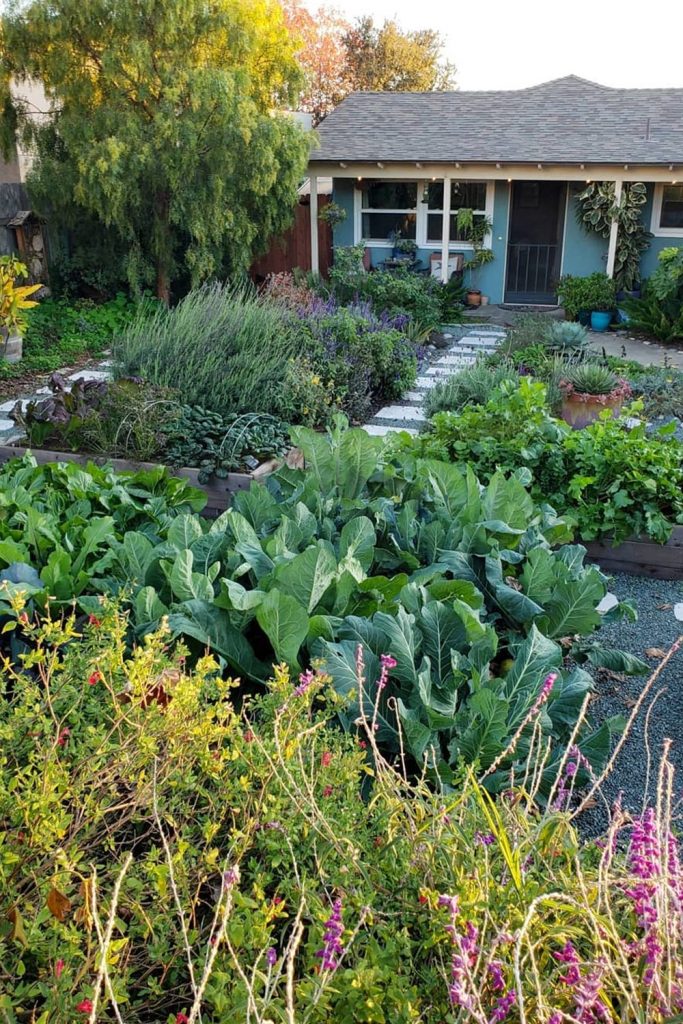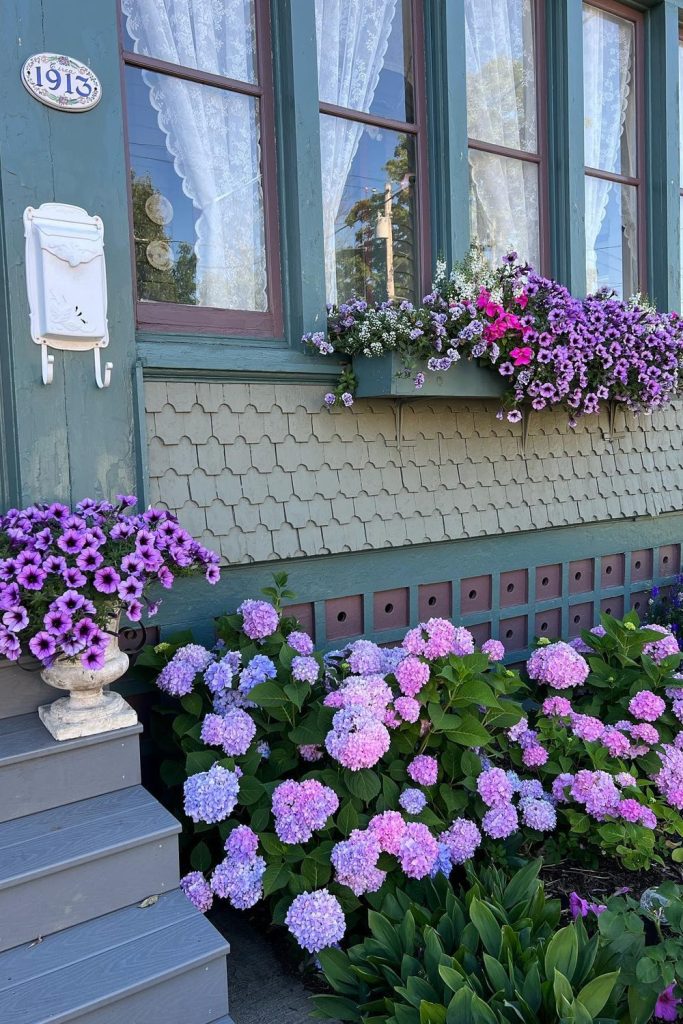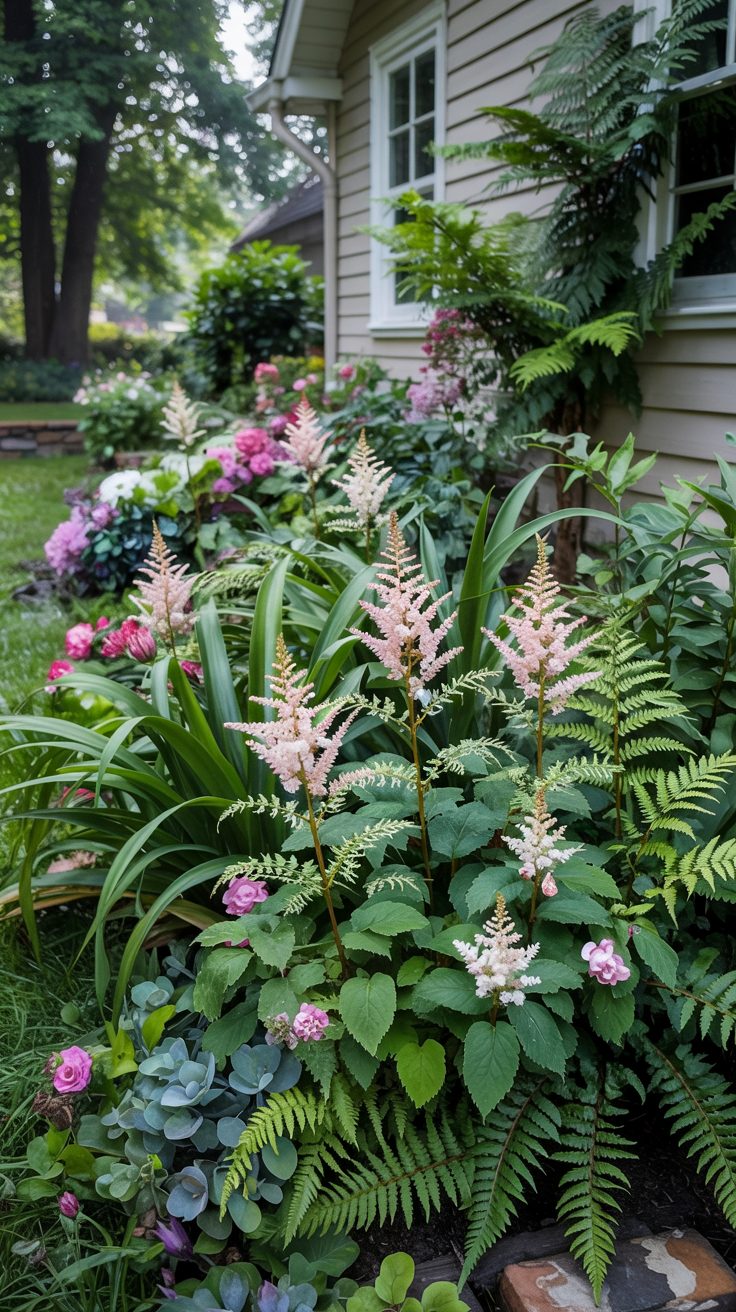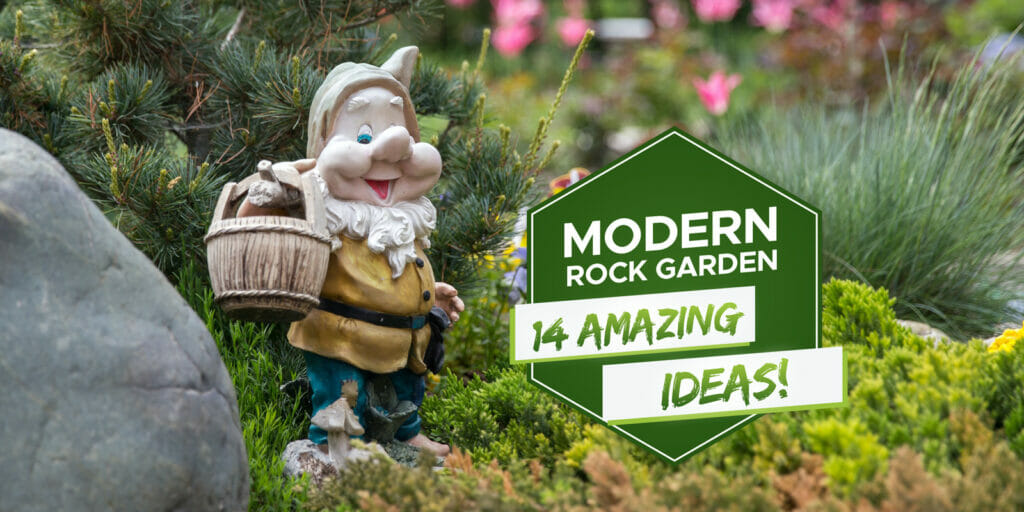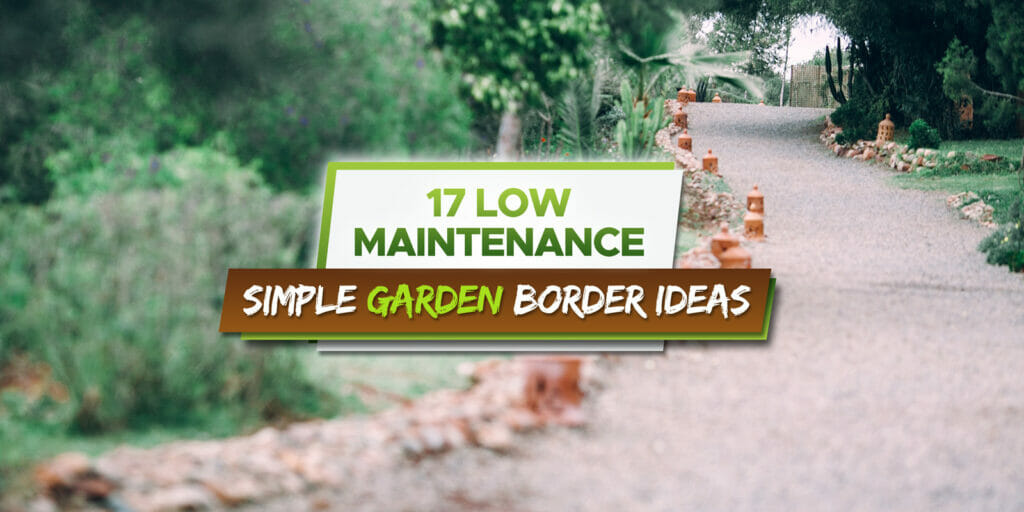Ever walked up to a house and thought, “Wow, that front garden just works”?
That’s the power of a well-designed flower bed. It instantly boosts your home’s curb appeal and creates a warm, welcoming feel for guests (and let’s be honest, for you every time you walk up the path!). 🌿
The good news?
You don’t need a landscaper or a huge budget to make it happen. With a few smart plant choices and some simple design ideas, you can transform that strip of space along your house into a vibrant mix of color and texture.
Whether you love easy-care plants that pretty much take care of themselves, or bold blooms like hydrangeas and roses that make a statement, there’s a combo to match your style — and your schedule. 🌸
Lavender and Salvia Border with Mulch
Lavender and salvia create a perfect partnership for front yard flower beds. These drought-tolerant plants offer beautiful purple blooms and fragrant foliage. You can plant them in alternating patterns or group clusters together for maximum impact.
The key to success is proper mulching around your plants. Spread a 2-3 inch layer of organic mulch around the base of each plant. This helps retain moisture and keeps weeds away from your flower bed.
Choose a sunny spot against your house for the best results. Both plants need at least 6 hours of direct sunlight daily. Water them deeply but less frequently to encourage strong root growth and prevent overwatering issues.
Succulent and Rock Garden Mix
Mixing succulents with rocks creates a stunning front yard flower bed that needs very little care. You can use river stones, lava rock, or gravel as mulch around your plants. This combination looks modern and stays beautiful all year long.
Choose succulents like aloe, echeveria, and agave for the best results. Place them with plenty of space between each plant so they can grow properly. The rocks help drain water and keep weeds away from your plants.
Start with larger rocks as your base, then add smaller pebbles or gravel around your succulents. This creates different textures and heights in your garden bed. The contrast between smooth stones and spiky succulents makes your front yard stand out.
Classic Rose Bushes with Boxwood Edging
Rose bushes paired with boxwood edging create a timeless front yard design. The neat boxwood borders make your colorful roses stand out while keeping the garden looking tidy and organized.
Boxwoods work perfectly as low hedges around rose beds. They need similar growing conditions as roses and are easy to trim into clean lines. You can choose compact boxwood varieties that stay short for neat borders.
This combination works well along walkways or against your house foundation. Plant your roses first, then add the boxwood border around them. The green backdrop makes red, pink, and white roses pop with vibrant color.
Drought-Tolerant Penstemon Cluster
Penstemon plants create stunning flower beds right against your house with minimal water needs. These hardy perennials produce tall spikes of tubular flowers in colors like purple, pink, red, and white. They bloom from late spring through fall.
You can plant different penstemon varieties together for a colorful display. Mix shorter varieties in front with taller ones in back. The plants grow 1 to 4 feet tall depending on the type you choose.
Penstemon thrives in well-draining soil and full sun to partial shade. Once established, these plants need very little water and care. They attract hummingbirds and butterflies to your front yard while requiring almost no maintenance from you.
Red Geraniums with White Alyssum Accent
Red geraniums create bold focal points in your front yard flower beds. Their bright red blooms stand out against green leaves and add instant color to any space near your house.
White alyssum makes the perfect partner for red geraniums. The small white flowers spread low along the ground and soften the bold red blooms above them. This creates a nice mix of heights and colors.
You can plant this combo in garden beds or large containers. The alyssum will spill over edges while the geraniums stay upright. Both plants are easy to grow and bloom for months in warm weather.
Hydrangea Shrub Bed with Ornamental Grasses
You can create a stunning front yard bed by pairing hydrangeas with ornamental grasses. This combination gives your garden both structure and softness. The grasses add movement when they sway in the breeze.
Plant your hydrangeas as the main focal points in the bed. Choose varieties like Little Lime or Limelight for consistent blooms. Fill in around them with fountain grass or feather reed grass for texture contrast.
Your ornamental grasses will provide year-round interest even after hydrangeas finish blooming. The grasses turn golden or tan in fall and winter. This creates a beautiful backdrop against your house while keeping the bed looking full through all seasons.
Daylilies Group with Stone Pathway
A stone pathway paired with grouped daylilies creates a stunning front yard display. Plant daylilies in large clusters along both sides of the walkway for maximum impact. This mass planting approach makes the flowers look bold and dramatic.
Choose stone materials that match your home’s style. Natural flagstone works well with traditional houses, while concrete pavers suit modern designs. The pathway should be wide enough for two people to walk comfortably side by side.
Daylilies bloom in the morning and come back year after year with little care. Space the flower groups about three feet apart from the stone edges. This gives the plants room to grow and keeps the pathway clean and easy to use.
Lavender, Catmint, and Sedum Combo
You get year-round beauty when you plant these three tough plants together. Lavender brings purple spikes and sweet smell in summer. Catmint adds soft blue flowers that bloom from spring to fall.
Sedum fills in the gaps with thick green leaves and bright fall flowers. These plants all love sun and dry soil. They work great in spots where other flowers might struggle.
Plant lavender in back since it grows tallest. Put catmint in the middle for its spreading habit. Use sedum as your front border plant. This combo needs very little water once settled and looks good even in winter.
Mixed Perennials with Seasonal Bulbs
You can create year-round color by mixing perennials with seasonal bulbs in your front yard flower bed. This combination gives you steady blooms from early spring through late fall.
Plant spring bulbs like tulips and daffodils between your perennial plants in fall. The bulbs will bloom first in spring, then your perennials take over as the weather warms up. Summer bulbs like gladiolus add height and drama to your bed.
Choose perennials that complement your bulb colors. Purple salvia pairs well with yellow daffodils. White tulips look great with pink bleeding hearts. This layered approach keeps your flower bed interesting throughout the growing season without much extra work.
Tall Ornamental Grasses Behind Low-Growing Perennials
This design creates natural layers in your front yard flower beds. Plant tall grasses like fountain grass or miscanthus in the back row. Add shorter perennials in front to build depth and visual interest.
The height difference makes both plant types stand out better. Tall grasses can reach 3-4 feet and provide a nice backdrop. Low-growing flowers like sedums or hostas fill the front space perfectly.
Choose grasses that grow upright rather than spreading wide. This keeps your bed neat and organized. The combination adds texture and movement while creating a balanced look that works well against your house.
Coral Bells with Hostas for Shade
Coral bells and hostas make one of the best plant combinations for shady flower beds. Both plants thrive in shade and require similar care, making them easy to grow together.
Hostas work well as backdrop plants since they grow taller and wider than coral bells. Place the hostas behind the coral bells to create layers in your flower bed. The large hosta leaves provide a nice contrast to the delicate coral bell foliage.
This pairing gives you year-round color in your shade garden. Coral bells offer colorful leaves in shades of purple, red, and green. Hostas add texture with their broad leaves and tall flower spikes in summer.
Compact Boxwoods Flanking Front Steps
Compact boxwoods make perfect guardians for your front steps. These small, rounded shrubs create a welcoming entrance that looks neat year-round. Their dense green foliage stays attractive through all seasons.
Place one boxwood on each side of your steps for balance. Choose dwarf varieties that won’t outgrow the space or block your walkway. These plants work well in containers or planted directly in the ground.
Your boxwoods need minimal care once established. Trim them lightly in late spring to keep their compact shape. They handle shade and sun well, making them ideal for most front yard conditions.
Coneflowers with Black-eyed Susans
You can create a stunning flower bed by pairing purple coneflowers with bright yellow black-eyed Susans. These two flowers make a perfect match with their contrasting colors and similar growing needs.
Both plants are tough perennials that come back year after year. They love full sun and can handle dry conditions once established. You won’t need to water them much after the first season.
Plant them in groups rather than mixing them randomly. Put three to five coneflowers together, then add a cluster of black-eyed Susans nearby. This creates bold patches of color that look natural and eye-catching against your house.
Creeping Thyme Ground Cover
Creeping thyme creates a beautiful carpet of color right against your house foundation. This low-growing plant spreads naturally to fill gaps between rocks and along walkways. You’ll enjoy purple, pink, or white blooms that appear in late spring.
This ground cover works well in sunny spots where grass struggles to grow. Plant it between stepping stones or in narrow strips along your house. The fragrant leaves release a pleasant scent when you walk on them.
Creeping thyme needs very little care once established. It grows in poor soil and handles dry conditions well. You can choose between different types like Thymus serpyllum or Thymus praecox depending on your climate and coverage needs.
Native Wildflower Patch with Decorative Rocks
You can create a stunning flower bed by mixing native wildflowers with decorative rocks. This design brings natural beauty to your front yard while supporting local wildlife. The rocks add texture and help define different areas of your flower bed.
Choose native flowers like black-eyed Susan, purple asters, and butterfly weed for your patch. These plants grow well together and attract bees and butterflies. Native flowers need less water and care than other plants, making them perfect for busy homeowners.
Use river rocks or gravel around the edges of your wildflower patch. The rocks help keep weeds out and make your flower bed look neat. You can also scatter smaller stones throughout the planting area to create natural pathways and add visual interest.
Compact Dwarf Alberta Spruce with Heuchera
You can create a stunning flower bed by pairing compact dwarf Alberta spruce with colorful heuchera plants. The spruce grows slowly to about 6-8 feet tall and naturally forms a perfect pyramid shape without any pruning.
Plant your dwarf Alberta spruce as the main focal point in your bed. Choose a spot with full to partial sun and well-drained soil. The evergreen provides year-round structure and stays compact, making it perfect for front yard spaces.
Add heuchera plants around the base of your spruce for beautiful color contrast. These shade-tolerant perennials come in purple, burgundy, lime green, and silver leaves. They work well under the spruce’s canopy and bloom with delicate flower spikes in spring and summer.
Vibrant Marigolds with Sweet Potato Vine
Marigolds and sweet potato vines create a perfect partnership for your front yard flower bed. The bright orange and yellow marigold blooms stand out against the trailing green or purple foliage of sweet potato vines. This combination works well in both traditional garden beds and raised planters.
Plant your marigolds in clusters of three to five for the best visual impact. Space them about 6 to 8 inches apart to give them room to grow. The sweet potato vines will spread and fill in the gaps between the marigolds.
This pairing thrives in full sun and handles heat well during summer months. The marigolds bloom continuously until frost, while the sweet potato vines provide consistent foliage color. You can choose chartreuse, deep purple, or bronze sweet potato vine varieties to match your home’s style.
Kale and Ornamental Cabbage in Fall Display
Ornamental kale and cabbage create stunning fall displays right against your house. These plants feature beautiful rosettes in deep purples, bright greens, and cream colors. Their vibrant foliage gets more colorful as temperatures drop.
You can use large ornamental cabbage or kale plants as centerpieces in your flower beds. Ring them with pansies or violas in matching colors for a layered look. These plants work well with mums and ornamental grasses too.
Plant ornamental kale and cabbage in fall for best results. They thrive in cooler weather when other flowers start to fade. Choose dwarf varieties for smaller spaces or tall varieties to add height to your display.
Bright Petunias with Creeping Jenny
This flower bed combination creates a stunning display right against your house. The bright petunias add bold color while creeping jenny provides a soft green carpet underneath.
Plant wave petunias in the back row closest to your house. Choose bright colors like hot pink, purple, or yellow for maximum impact. The creeping jenny will spread out in front, creating a beautiful contrast with its small green leaves.
This pairing works well because both plants love similar growing conditions. They thrive in full sun to partial shade and need regular watering. The creeping jenny will spill over bed edges, softening hard lines while the petunias bloom all season long.
Ferns and Astilbe for Moist Shade Areas
Ferns and astilbe make perfect partners for shady spots along your house. These plants love cool, moist soil and need very little care once planted. You can create a lush garden bed that looks full and green all season.
Astilbe brings beautiful feathery flowers in spring and early summer. The blooms come in white, pink, red, and purple colors. After flowering, the plants keep their pretty leaves throughout the growing season.
Ferns add different textures and shapes to your flower bed. They stay green from spring until fall frost. Plant larger ferns like ostrich fern in the back and smaller ones like lady fern in front. Mix them with astilbe for a natural woodland look.
Design Principles for Flower Beds Against the House
Good design combines colors, heights, and flow patterns to create flower beds that look natural and balanced. These three elements work together to make your house look welcoming and well-planned.
Balancing Color and Texture
Choose a main color scheme with 2-3 primary colors to avoid a chaotic look. Warm colors like red, orange, and yellow make your house feel closer and more inviting. Cool colors like blue, purple, and white create a calm, spacious feeling.
Mix different leaf shapes and sizes to add interest. Pair broad-leafed plants like hostas with narrow-leafed grasses or spiky plants. This creates contrast even when flowers aren’t blooming.
Use the 60-30-10 rule for color balance:
- 60% neutral greens from foliage
- 30% your main flower color
- 10% accent colors for pops of interest
Add plants with different textures like fuzzy lamb’s ear, glossy leaves, or rough bark. This keeps your flower bed interesting throughout the year.
Choosing the Right Plant Heights
Layer plants in three tiers to create depth and prevent blocking views. Place tall plants (3-6 feet) closest to the house foundation. Medium plants (1-3 feet) go in the middle section. Short plants (under 1 foot) belong at the front edge.
Keep foundation plantings below window sills. This lets light into your house and prevents security issues. Tall shrubs should not block doors or walkways.
Use the mature plant size when planning, not the current size. A small shrub might grow 8 feet wide in five years. Check plant tags for spacing requirements.
Height Guidelines:
- Foundation wall: 4-6 feet maximum
- Under windows: 2-3 feet maximum
- Pathway edges: 1-2 feet maximum
Creating Visual Flow Along the Foundation
Repeat the same plants or colors every 10-15 feet to create rhythm. This ties the whole bed together instead of looking like separate plant groups.
Create gentle curves rather than straight lines. Curved edges look more natural and help guide the eye along your house. Use a garden hose to plan curves before digging.
Connect separate bed areas with similar plants or mulch. This makes your landscaping look planned rather than random. Bridge gaps between beds with groundcover or stepping stones.
Plant in odd-numbered groups of 3, 5, or 7 for the most natural appearance. Even numbers look too formal for most home landscapes.
Maintenance Tips for Front Yard Flower Beds
Proper timing for seasonal tasks keeps flower beds healthy year-round. Water drainage prevents root rot and foundation problems near your house.
Seasonal Upkeep Strategies
Spring brings the most important maintenance tasks. Remove dead plant material and old mulch in March or April. Cut back perennials to 2-3 inches above ground level.
Apply fresh mulch 2-3 inches deep around plants. Keep mulch 6 inches away from your house foundation to prevent moisture problems.
Summer requires minimal work in well-planned beds. Deadhead spent flowers weekly to encourage new blooms. Pull weeds when soil is moist after rain or watering.
Trim overgrown shrubs in late June. Cut branches back by one-third to maintain shape without shocking plants.
Fall preparation protects plants through winter. Stop fertilizing 6-8 weeks before first frost. Leave ornamental grasses and seed heads for winter interest.
Plant spring bulbs in October or November. Choose varieties like daffodils and crocuses that deer avoid.
Winter tasks focus on protection. Wrap tender shrubs in burlap if temperatures drop below 10°F. Avoid walking on frozen plants or soil.
Watering and Drainage Considerations
Check soil moisture 2-3 inches deep before watering. Most flower beds need 1 inch of water per week including rainfall.
Water early morning between 6-10 AM. This timing reduces disease risk and water loss from heat.
Poor drainage causes more plant deaths than drought. Install drainage tiles if water pools near your foundation after heavy rain.
Slope flower beds away from your house at 6 inches per 10 feet. This prevents water damage to basement walls and foundations.
Drip irrigation works best for beds against houses. Soaker hoses deliver water directly to root zones without wetting leaves.
Avoid overhead sprinklers near foundations. Water spray can seep into basement walls and attract insects.
Preventing Pest and Disease Issues
Air circulation prevents most fungal diseases. Space plants according to mature size recommendations on plant tags.
Remove infected leaves immediately. Throw diseased material in trash, not compost piles.
Common pests include aphids, spider mites, and scale insects. Spray affected plants with insecticidal soap every 3-4 days until pests disappear.
Encourage beneficial insects with native plants. Ladybugs and lacewings control many garden pests naturally.
Mulching reduces pest problems by eliminating weed competition. Use organic mulches like shredded bark or compost.
Inspect plants weekly during growing season. Early detection prevents small problems from becoming major infestations.

